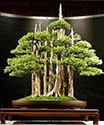|
jadebullet posted:That's a relief. Style wise I would love to try for something similar to the Trident maple in the op. When you say cut back to one to two pairs of leaves you mean pinch off some of the leaves until there are only about 4 remaining correct? And only leaves not branches. As for a balanced fertilizer what do you reccommend. I tend to use bonemeal for most of my plants around here but that is because I have lovely soil and i am not sure how balanced it is. Thanks for the help BTW. Japanese maple thicken very slowly in a bonsai pot. I think you should probably be aiming for something like this:  When I say cut back to one or two pairs of leaves I mean use a pruner and cut off the branches an inch or so above where the leaf comes out. I also suggest waiting a month or so to do this and observe the health of the tree in the mean time. If it is in good health you can do it again if you have 6ish weeks to let it regrow before winter dormancy begins. A balanced fertilizer means an equal amount of nitrogen/phosphorus/potassium. I use vigoro 10-10-10. I personally feel like leaf pinching is for trees in an advanced state of training. Here is an excellent article with pictures of how a maple is developed: http://walter-pall-bonsai.blogspot.com/2013/02/refurbishing-japanese-maple-hedge.html Your numbered list looks good with the added technicality that watering should be when almost dry and if that is every other day than so be it. I'd still rather re-pot in spring but I can understand why you would want to get it into loser soil and that is kind of a region dependent thing. Fake edit: when previewing this I saw unprofessional had posted and I feel like I should point out I don't really disagree with what he is saying at all but feel like I am presenting a different viewpoint.
|
|
|
|

|
| # ? May 6, 2024 13:32 |
|
That article is awesome. Good advice, too. There are lots of ways to accomplish the same goals. I know there are lots of bonsai people that would advocate for you ripping that tree out of its pot and putting it in the ground for a few years to get some size on it - it's all how you want to go about it.
|
|
|
|
So I've been happy to see a lot of leafy growth from my newish-to-me Hedge Maple tree, but I've been plagued by something eating the leaves. What can I do (insecticides or other) to try and prevent the local bugs from killing my bonsai? Is there a preferred brand or method people are using?
|
|
|
|
Neem oil is a popular organic option, but to have the best chances, it's going to be important to figure out what's eating it.
|
|
|
|
Yeah, different pests take different kinds of treatment. I'm assuming by eating it you mean that entire leaves are gone. Snails, grasshoppers, or deer are common culprits for that, but as far as I know they usually aren't too into maples.
|
|
|
|
Thank you for posting that article Illudere. It is very helpful and it makes a very good point about potentially starving your tree if you cut off too much new growth. The only thing that struck me as odd about it was the guy complaining about the wound in the front trunk. I am just going to assume that it is because he shows his trees and that would be a negative towards the tree correct? I only ask because I personally liked that it had that old wound on there. Lots of real trees around me have similar wounds due to wind and other traumas during their lives so it just struck me as something interesting on the tree, and helped the effect of having a miniaturized tree. That being said, it wouldn't be something that I would want to do intentionally or anything like that. I just thought it was an interesting feature of the tree. Also thank you for the help as well unprofessional and Mr. Soop. I am getting a bunch of information and I am feeling confident that I can successfully raise this tree. In regards to the pot, how urgently do I need to get a new pot? Would I be able to hold off until it goes dormant in fall, or is it so small that it would potentially kill the tree if I wait that long? When I inspected the soil to answer the question about it I felt quite a bit of thin roots forming a thick web in the soil. The soil was also moist but not wet when I checked it. This was 1 day after I bought it and I wasn't sure when it was last watered at the store. I am not sure of the soil condition today since I am at school until later on in the day, but I will check it out when I get home. To elaborate on my question about lighting, the porch is on an eastern exposure and has a roof over top of it, but no walls on the north, east, and south sides. Too the east there are a wall of tall pine trees which will block direct sunlight until about 10am. I live in Pennsylvania for light angle and temperature purposes. Our summers tend to be a mix of very hot, humid days, warm humid overcast days, and storms. I have two questions about this location: 1) Would the somewhat direct sunlight in the morning be too much for the maple if I put it in that location during the summer months? 2) Would the tree get enough sunlight during the times when it is shaded by the porch roof and the house itself? (The building is 1 story so it doesn't create too much blockage of sunlight) I was thinking of putting it on the south eastern corner of the porch, just out of the direct light at noon but I am still worried about burning the tree, or starving it of light. @Korwen: Do you have any idea what the insects look like? Look closely at the leaves to see if you have aphids. Another sign of aphids would potentially be ants climbing around the tree in order to "milk" the aphids. Also, where is the damage to the leaves? Is it more towards the outside of the leaves, as if something were munching from the outside in, or is it spotted like something was just eating at random spots on the leaf? If it is mainly outside some sort of caterpillar might be the culprit. In that case just keep an eye out for the caterpillar and move him to some other plant. They tend to pupate quite quickly and are more interested in how much they eat rather than what they eat. Also, check the tops and bottoms of your leaves for egg sacs that might need to be scraped off. If it is more randomized and internal it could be a pest like aphids. I know ladybug larva is a huge natural predator of aphids so that is one option. Other predators of aphids are crab spiders, lacewing larva(aphid lions) various types of fly, and some wasps. It could also be other types of pests, but for the most part they have predators. Now, I am very new to the bonsai hobby so take my advice as you will regarding elimination since it is based on a traditional flower garden and not something designed strictly for long term ornamentation. I personally advise against insecticides, especially since you can focus your attention on a single plant and visual inspection won't take too much time. That and you don't want to have to deal with insecticide every time you touch the tree. The first step would be to identify what is eating your tree. Just take time throughout the day to do a quick visual inspection of the plant, probably less than a minute at a time. Caterpillars that are found can be picked off, and other pests can be researched and eliminated. You can also squish most pests by hand if you want. I still say just move caterpillars though. They are just hungry and very temporary so there is no real benefit to killing them, unlike aphids. If you do get something like aphids though, I recommend transplanting a few of them onto a non bonsai plant before killing the rest. This may sound counter intuitive, but by giving them somewhere else to live and colonize(as well as eat. Keep this in mind when picking the somewhat sacrificial plant) you should attract their natural predators. This is one of the reasons what I advise against insecticides, they are temporary solutions and sacrifice a long term benefit, for a short term gain. By using insecticides you not only kill the pest, but also have a chance of killing off predatory insects. Then when the pests eventually come back it doesn't necessarily mean that the predators will come back with them. (also the pests could start getting immune to the insecticides) It may take more work, and probably quite a bit of squishing depending on what your pest is, but in the long run you should end up having a nice ecosystem near the location of your bonsai that will contain enough predators to take care of whatever pests you miss. Plus, since it is a bonsai, taking the time to remove pests by hand shouldn't be too different from the normal care given to it. Just be glad that there aren't any boring pests to deal with. There is nothing worse than having to slice into your plant to remove a fat grub that is killing your plant and might soon infect your other plants like what you have to do if you grow irises. Also, some predators are attracted by certain plants so that could be useful in attracting them if you have a garden. Edit: Oh, if you have snails or slugs that are causing your problem, surround the outside of the pot with cornmeal for a little while. The slugs will eat it and it will expand in their stomach, killing them. Grasshoppers on the other hand will need quite a bit more work. Your best bet would be to make sure that your house is very bird friendly. jadebullet fucked around with this message at 18:50 on Apr 8, 2013 |
|
|
|
|
jadebullet posted:Thank you for posting that article Illudere. It is very helpful and it makes a very good point about potentially starving your tree if you cut off too much new growth. The only thing that struck me as odd about it was the guy complaining about the wound in the front trunk. I am just going to assume that it is because he shows his trees and that would be a negative towards the tree correct? I only ask because I personally liked that it had that old wound on there. Lots of real trees around me have similar wounds due to wind and other traumas during their lives so it just struck me as something interesting on the tree, and helped the effect of having a miniaturized tree. That being said, it wouldn't be something that I would want to do intentionally or anything like that. I just thought it was an interesting feature of the tree. He definitely shows his trees and is a very famous artist who is looking for perfection. As an art form you can make your trees pleasing to you but if you want to be taken seriously there are rules to follow. Maples are generally supposed to be smooth barked and not knobby. Bonsai trees are sort of an idealized exaggeration of nature so some trees might have a wound on the trunk as a feature but it will often be exaggerated by hollowing out and darkening the interior. As far as the pot being to small, I don't think it is a shallow enough pot to hurt the trees health. The only problem would be if it was root bound which would lead to slow, laggy growth, and it seems to be growing okay? If it's growing okay I wouldn't re-pot until fall. The rule of thumb on light is to protect the maple leaves from harsh mid-day sun but get lots of morning and evening sun. The porch sounds safe enough and just keep an eye on it for leaf scorch. Even healthy maples can have some leaf scorch by the end of summer, it just depends on how careful their owners were and if they wanted to show them or not.
|
|
|
|
So I think I messed something up, hopefully not fatally. Two nights ago I set my maple outside on the porch. The next morning I checked on it at about 10 am and all of the leaves had shrivled up and the soft stems had begun to droop. I put it in the shade and since the soil felt relatively dry I gave it some water. It was about 66 degrees and sunny yesterday and there was a constant wind all day. The buds seemed to open by the end of the day but the existing leaves did not recover and are shrivked and dried out. I checked it this morning and it doesn't seem to have improved. The leaves are still wilted as well as the soft stems. I now have it in a shadier area and today is just as hot but overcast. Did the plant get sun scorched or did I inadvertantly mess something else up? Do you think that the tree will recover? This is the first time the tree has actually been outside in a long time most likely.
|
|
|
|
|
Where are you at? It's still getting pretty cold around here for a leafed out tree to be outside at night. The leaves will fall off, but maples are pretty hardy - I would expect to see it rebud soon enough. If it drops all its leaves, you can ease up on water (once a week) 'till it buds out.
|
|
|
|
I live in Pennsylvania. Should I bring the tree in at night until it warms up more?
|
|
|
|
|
I decided to dive into bonsai gardening after being enamored with the practice since I was a child and what do you know, I made the amateur mistake of buying a bonsai kit to grow black pine seedlings that aren't at all suited for the environment I'll be growing them in. Whoops! So now I want to grow a bonsai from trimmings and basically what I'd like to know is what should I be on the look out for when choosing a good trimming? Things beside a healthy looking parent tree. What would an ideal branch look like? I know from the OP that the time is nearing to gather good trimmings so I'd like to be prepared for when the time comes. I want to grow at least one sick rear end bonsai before I'm too old and dead to have grown something respectable, so now is the ideal time to get started on that project. This thread has been a great resource for all the noob questions that a Google search hasn't been able to answer for me.
|
|
|
|
Jade, an unheated garage or place like that would do for any night that's getting close to or is going to freeze.AwwJeah posted:now I want to grow a bonsai from trimmings and basically what I'd like to know is what should I be on the look out for when choosing a good trimming? Of interest to some of you might be a few conifer grafts I did this year. Won't be bonsai'ing any of them, but will be doing a niwaki type pruning to some of the pines. Pinus densiflora 'Oculus-draconis' 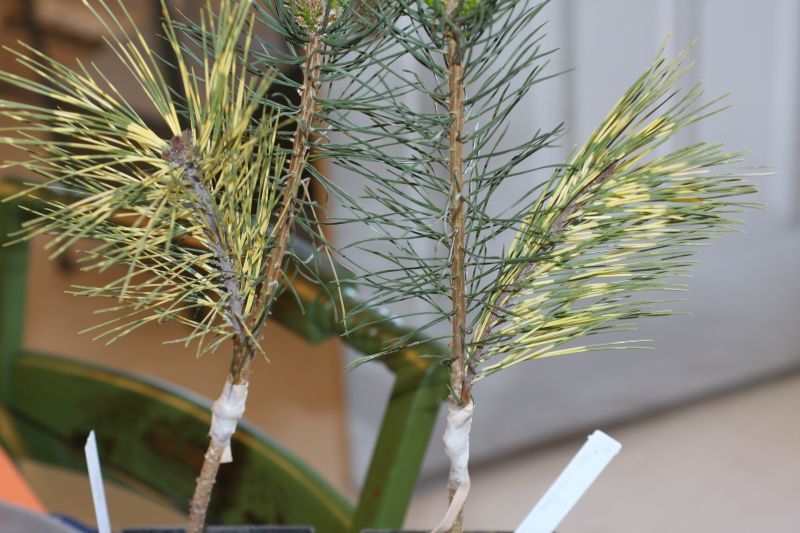 Chamaecyparis obtusa 'Nana Aurea' 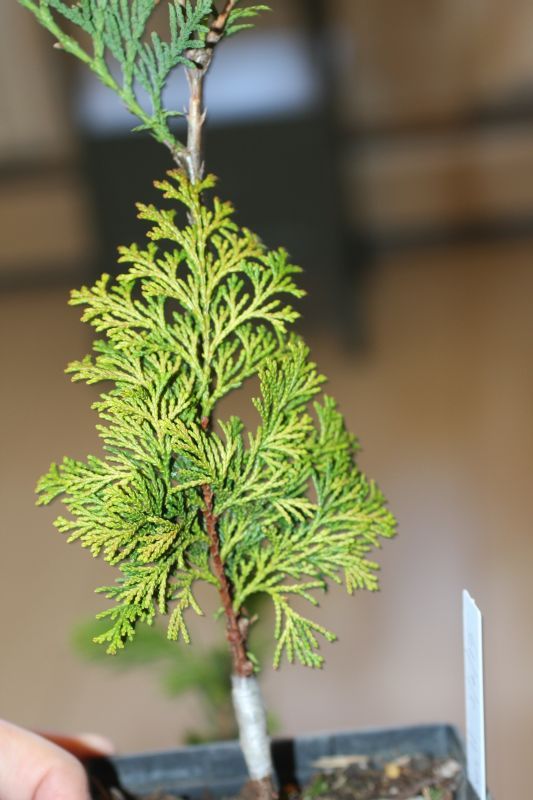 Picea orientalis 'Skylands' 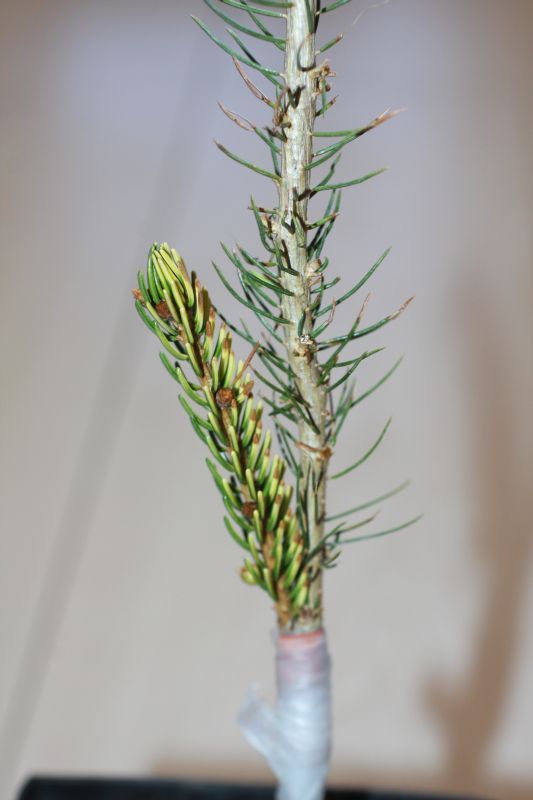 Here is a mature 'Skylands' 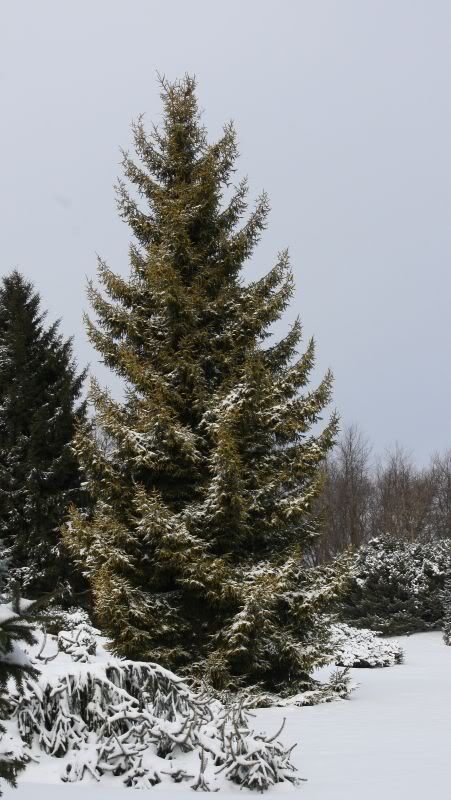 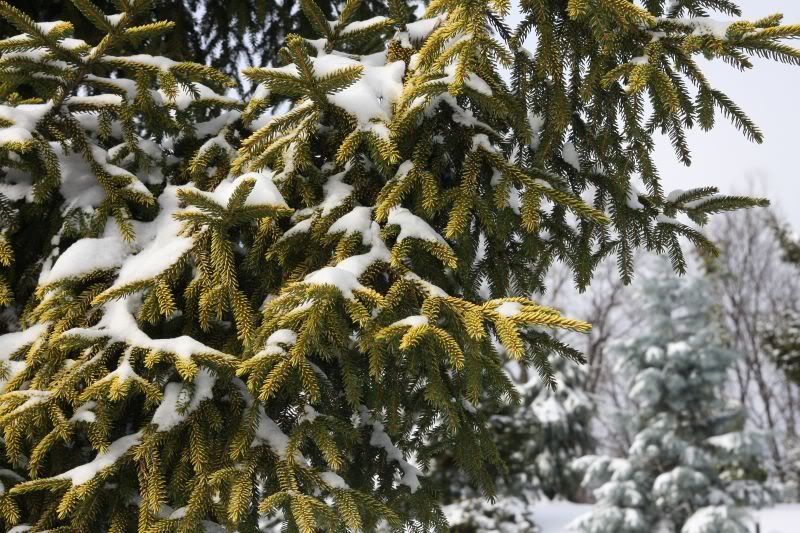
|
|
|
|
AwwJeah posted:I decided to dive into bonsai gardening after being enamored with the practice since I was a child and what do you know, I made the amateur mistake of buying a bonsai kit to grow black pine seedlings that aren't at all suited for the environment I'll be growing them in. Whoops! I'd recommend going for nursery stock rather than trimmings or air layerings. Even with a nice thick air layering, you might need several years of in ground growth to get something nice to work with and, no offense, but learning how to bonsai is going to take killing a few trees. After investing a few years into growing your cutting up, that could be pretty heartbreaking. Nursery stock will be better developed, you can get a reasonably nice looking tree in a year or two and you'll be able to hack the poo poo out of it, kill a few trees and not feel so bad. 5 gallon junipers are like, what, $20? Buy five of them, see how much pruning they can handle, how to get the most growth out of them, etc. save up some money and after 2-3 years buy a well developed juniper of the same species. Look for a tree with lots of low branches with foliage close to the trunk, nice radial spread of roots and a trunk with interesting lines. http://ofbonsai.org/selecting-and-purchasing/bonsai/bonsai-on-the-cheap
|
|
|
|
Thanks for the great article. I honestly had no clue that most bonsai are reduced down dramatically from their original size and that's probably THE most valuable piece of beginner information I've gathered so far. That's a HUGE development in my understanding of bonsai. After poking around online, I think I'll be getting myself some 3-5 gallon Maple, Cherry, and a Boxwood to see which of the 3 will fair best under my supervision. I'll for sure be popping into this thread after my visit to the nursery because I'm going to need all the goon advice I can get to make this endeavor successful. Is there an ideal time of year to be visiting a nursery for these particular plants? I imagine the costs and quality of plants at a nursery must fluctuate dramatically during certain periods of any given season? Is this even something I should be taking into account and concerning myself with? AwwJeah fucked around with this message at 04:37 on Apr 12, 2013 |
|
|
|
I'm doing it. I'm going to bonsai some chilis this year, following Fatalii.net instructions. It's probably a bit late to start some seedlings this year, but oh well. They're not 'true' bonsai, because a chili plant isn't a tree, but I think it's about my speed. I just ordered some Trinidad Perfume chili pepper seeds, which are not supposed to be hot (and therefore should be palatable to my mother who cannot stand capsicum) and we'll see how it goes. If this is moderately successful I'll see about picking up some nursery trees later. Anyway, the basic plan for chili bonsai is to grow the chili outside in full sun (or as much full sun as western Oregon can give me) in five gallon pots to try to get the plant as big as possible for a nice large mature looking "trunk". When fall comes around and fruiting is over, take them inside and do some serious pruning and training down to bonsai size. Apparently chilis can handle aggressive pruning like that just fine. The site says that I can maintain them like that for as long as I want, or replant them outside the next year for another large bush (then take inside and trim to bonsai size again)
|
|
|
|
platedlizard posted:I'm doing it. I'm going to bonsai some chilis this year, following Fatalii.net instructions. It's probably a bit late to start some seedlings this year, but oh well. They're not 'true' bonsai, because a chili plant isn't a tree, but I think it's about my speed. I just ordered some Trinidad Perfume chili pepper seeds, which are not supposed to be hot (and therefore should be palatable to my mother who cannot stand capsicum) and we'll see how it goes. If this is moderately successful I'll see about picking up some nursery trees later. I've been really looking into this and apparently, some peppers (like bell peppers) don't become woody shrubs and some just randomly die near the end of season. The fatalii guide unfortunately does not specifically say which species do and don't make good "bonsai". I've been thinking of using habaneros and aji amarillos, and I'm confident the habaneros will work because they're listed as perennials and described as hardy shrubs, but does anyone know if the aji amarillos will be any good?
|
|
|
|
AwwJeah posted:Thanks for the great article. I honestly had no clue that most bonsai are reduced down dramatically from their original size and that's probably THE most valuable piece of beginner information I've gathered so far. That's a HUGE development in my understanding of bonsai. No problem, if you look at some of my bonsai, you can see where trunk chops have been made. You should probably be able to grow anything that they stock in your local nursery. Pruning, especially major pruning like a trunk chop or what have you, can be stressful and the timing depends on the species. With that said, with cheap nursery stock, you might want to play around with it, see what the plants can tolerate and what kills them. I don't know that the costs will fluctuate all that much, you should be ok just going in with fifty bucks and getting a small collection together. If you can find a nice ficus, they tolerate weed whacking really well.
|
|
|
|
AwwJeah posted:Thanks for the great article. I honestly had no clue that most bonsai are reduced down dramatically from their original size and that's probably THE most valuable piece of beginner information I've gathered so far. That's a HUGE development in my understanding of bonsai. All three are good choices. Black cherries are especially hardy and take abuse like crazy. For starting out, don't spend more than $10-$15 on a tree. The earlier in the season you can get them, the better.
|
|
|
|
I was going to post this video of how to create a juniper bonsai earlier this week for every one just thinking of starting the hobby and in light of the recent conversation it seems even handier now: https://www.youtube.com/watch?v=Iu-mh_wnx4g I really like juniper as a starting plant. Spend the little bit extra for a bigger plant with lots of branching to work with.
|
|
|
|
Muffy_the_Diver posted:After poring over the thread for the past couple days, I've got a couple questions for y'all! I've been toying with bonsai for a couple years now, but haven't ever given it a serious commitment. Hopefully I can buckle down and get some stuff started! Here are some of my hopefuls: A lot of people have given you great advice already, which is to give your plants more light, but I'd like to reiterate that advice. I'm not too sure how cold and rainy it gets in Oregon, but putting your plants outside even under a shaded/covered area should greatly increase the amount of UV rays it gets. Even better results with full sun.  Here's a picture of my plants:  I also have a rubber tree, two Crassula ovatas, a Crassula ovata var. 'Gollum', and a Portulacaria afra ('Variegata', but it's hard to see, in the tall orange pot with the undead rose plant in it), and they are grown in a shaded area with only evening sun to brighten them up  I think your jade plants are very healthy, but if you want them fill out both in foliage and girth, brighter light is the way to go. If you put your plants outside whenever you can, I can guarantee you'll see what you're looking for after a while. The only bad thing is that C. ovata and P. afra are very, very slow growing plants even under ideal conditions, but on the bright side, it gives you more time to plan your next bonsai steps with them? My advice for getting more branches on your rubber tree would be (once again) to put it outside, and then neglect it except for the occasional water. Your rubber tree is pretty tall as is, so I think once it gets bright light, it will spend some of its energy on producing side branches which is what happened with my plant. Plants don't really like to grow lanky and noodly, so they'll try and start over again in a different location along the trunk. Plants that are lanky only have enough energy to maintain its single apical meristem, but the lateral meristems will wake up with enough sun. But anyway, I really do think your jade plants are pretty and have good trunks to start with, so hopefully things go well!
|
|
|
|
platedlizard posted:I'm doing it. I'm going to bonsai some chilis this year, following Fatalii.net instructions. It's probably a bit late to start some seedlings this year, but oh well. They're not 'true' bonsai, because a chili plant isn't a tree, but I think it's about my speed. I just ordered some Trinidad Perfume chili pepper seeds, which are not supposed to be hot (and therefore should be palatable to my mother who cannot stand capsicum) and we'll see how it goes. If this is moderately successful I'll see about picking up some nursery trees later. Quite a lot of bonsai are made out of shrubs and such, so I'd say it counts as a bonsai as much as any boxwood tree. Many junipers and pines also have shrublike growth forms. I guess I'm not very impressed by the results, but it is nice that they grow so fast.
|
|
|
|
Today I bought a Japanese Juniper Bonsai at a craft show at my university. The guy selling it neglected to tell me that I was buying an outdoor plant and I was wondering how necessary it is that the juniper grow outside. I know it needs a dormant period during winter, so it it okay if I leave it indoors until fall comes around and then when it starts getting cold put it outside? I live in Baltimore city if that makes a difference. Here's a picture of it: 
|
|
|
|
Bengy posted:Today I bought a Japanese Juniper Bonsai at a craft show at my university. The guy selling it neglected to tell me that I was buying an outdoor plant and I was wondering how necessary it is that the juniper grow outside. I know it needs a dormant period during winter, so it it okay if I leave it indoors until fall comes around and then when it starts getting cold put it outside? I live in Baltimore city if that makes a difference. It probably won't be happy indoors. Generally they're only displayed inside for a few hours at at time before going back outside.
|
|
|
|
 These are three japanese maple saplings that I ordered from a seller on amazon. Ive got them in a perlite/soil mixture and ive done some very light pruning to two of the saplings. I think I over watered the plant on the far left so ive aerated the soil and put some extra perlite on top to try and soak up some excess water. Since ive planted them the leaves have perked up a lot which is nice to see. What should I be doing to get these guys going? My main mission thus far has been trying to get them healthy after their shipping. These were planted two days ago. also im in NC at zone 7b
|
|
|
|
Mix your perlite in, but looks good so far. My only concern would be the amount of organics in your mix (just judging by the look of the picture); from one of the garden professors: "Most landscapes that support trees and shrubs require 5-10% organic matter - not 20%. Overkill is overkill." People are way too scared about cutting their potting mix with inorganics, but it really does make your root system healthier and less prone to rot. There's nothing wrong with letting them grow for a season to ensure nice healthy trees. Take a look at the link Illudere posted earlier on an easy way to develop your trees from here on out.
|
|
|
|
Squirrel007 posted:
The bigger a pot you can put them in, the better. As unprofessional said, an inorganic mix would be great, I even like to use completely inorganic with my trees. This let's me regulate their nutrients and water myself, although it does mean that you have to be diligent about watering and fertilizing - at least I don't worry about rot. Even better than putting them in pots would be to put them in the ground and let them grow for five or ten years. If you're in NC, you should check out the growing grounds, really one of the best bonsai nursery's I've been to.
|
|
|
|
Crocoduck posted:If you're in NC, you should check out the growing grounds, really one of the best bonsai nursery's I've been to. Word! ill have to check it out next time im in charlotte. So should I be looking to replant my trees in a perlite/lavarock/small amt of organic matter mixture in the near future?
|
|
|
|
Whoa NC dudes out of nowhere! I'm in Greensboro/Winston, what about you guys?
|
|
|
|
Squirrel007 posted:Word! ill have to check it out next time im in charlotte. I dunno, depends on how organic the mixture you got now is. If you think it's holding on to water, I'd try to gently shake them out and put them in something that is much more free draining - your mix might be ok if the organic matter is tree bark and not cow poo poo. Root rot is a bitch and kills stuff like no other. Honestly though, I'd put them in the ground and work them with a few trunk chops over the years, because it's going to take forever to thicken them trunks up in a pot. You won't have much to work with for at least like, three or five years, even if you put it in the ground and let it grow freely, nevermind if you keep it in the pots. Might be able to get something like this:  or this  in terms of trunk thickness and shape after a year or two, then work on branching and reduction of root ball, etc., etc. but everything will go faster if it's in the ground, according to what I've read anyway. I only have a few trees growing in the ground right now to be honest. Hit Marc up at the growing grounds when you can, he has great bonsai stock, but it is a bit expensive - I'd guess you won't be able to find a tree for less than $150 or so, but every single one you find will have great potential. He won't see you without an appointment, and I'd encourage budgeting a full day to hang out. He doesn't have any prices written down, he just 'remembers' them for each tree, and I think that if you admit that you're a novice, let him share some of his wisdom and ask a lot of questions the price goes down. Bring cash, as far as I know he doesn't use credit card, although that might be changing. One of the few bonsai nurseries I've ever been to that actually grows the trees from seed/cuttings, and it's really worth your time to see how that process is done. I'm currently saving up money for a second trip out there :3. I don't want to sound like a billboard for the dude, but he does offer top notch stock that would be 4 or 5 times as expensive at any other nursery.  Baby black pine bonsai in foreground, trident maple in back ground. Crocoduck fucked around with this message at 02:03 on Apr 16, 2013 |
|
|
|
I currently live in an apartment so I dont really have much ground to plant in. If I were to plant them in 5 gallon buckets would I be doing better things for them?
|
|
|
|
Squirrel007 posted:I currently live in an apartment so I dont really have much ground to plant in. If I were to plant them in 5 gallon buckets would I be doing better things for them? I think I spoke too soon! I've been doing some reading, apparently overpotting is not a good thing. I might not be giving you the best advice, but I'd think that just continuously upgrading the size of the pot. http://www.bonsai4me.com/Basics/Basics%20Bonsai%20Myths%20Overpotting.htm
|
|
|
|
jackpot, back in January posted:This is my willow leaf fig that I posted a while back. Clearly things are...not optimal. But is it dead? Even though all the leaves are gone, almost every branch has green stems coming off of it, I've got to think that's a good sign. I'm watering it about every 3-4 days, just like the other one (that's still perfectly healthy), guess I'll see what happens to it.   Back around December/January this thing dropped every single leaf it had. I always had hope, because the branches were still green...but not a lot of hope. I watered it throughout the winter, and started seeing little tiny bits of leaves a few weeks ago. This is it today. And here's the avocado I thought for sure I'd killed! This thing was so young I thought for sure it was deader than dead, but in the last few weeks it's gone from nothing but a stem to this: 
|
|
|
|
This is a pretty cool resource! http://andyrutledge.com/book/index.html
|
|
|
|
Can't believe I'd never seen this thread before, there are some really rad trees in here and some excellent advice, goooood poo poo Mr Soop. I had no idea what to get my partner for her birthday, but given we've had some failed attempts at bonsai cultivation in the past I figured I'd pick her up a tree that's already coming along well 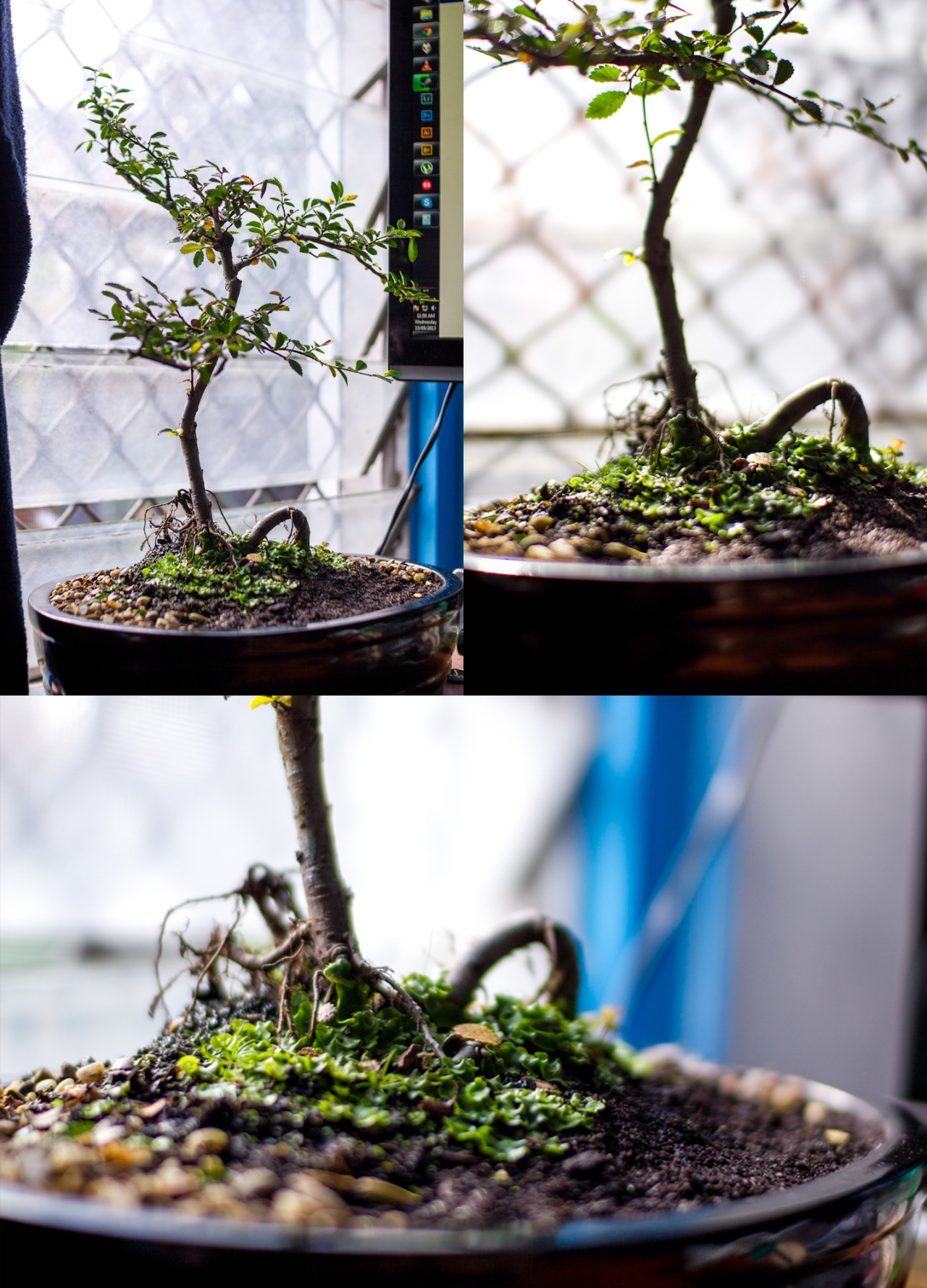 It's a ~30cm tall Chinese Elm that has really nice small leaves, though I'd like to get them smaller. I've done a little research and one my of family member's is actually one of Australia's leading bonsai-ers but between me not really having much of a knack for gardening and tight-lipped relatives not sharing too many secrets, I'm not sure where to take this Elm from here. It's late Autumn here and I can't quite tell whether he's going to suddenly drop all his leaves or not, the bonsai garden down the street had a lot of similar trees that had totally shed by now but this guy seems to be going strong. Anyway, there are really only 3 things I want to actively work on with this tree and that is: -promote smaller leaves - is there a particular technique for this? Some sources say pruning leaves is how you go about this but something tells me it's not that simple -prevent vertical growth - at perhaps just over 30cm tall, I feel like it's grown a bit too high for a slim tree. I'm not saying this as an expert or anything it just looks a bit odd to me and I'd really like to see it grow out from here. Should I just be snipping the top branches off as they grow up to keep the height down? Any other tricks to promoting outwards growth / more layers? -promote groundcover growth - not really about the tree here, but there's some nice green leafy stuff growing around the base and up the exposed roots of the tree. This stuff actually looks dope as hell and I'm not 100% sure what it is (Small, vivid green, rubbery-looking leaves with tiny smooth dimples in the middle of the leaves) but I'd like to get it to grow out and cover the rest of the exposed soil. Is there any problem with doing something like this? Any way to actively encourage it or do I just let it do it's thing? I've killed a number of young trees in the past through bad watering routines and too much/too little sun exposure so I'm adamant as poo poo about keeping this guy alive. The pot is actually quite large and holds a considerable amount of soil, so basically I've just been drizzling water around until all the soil is moist once or twice daily, does this sound about right? I've read elsewhere I should be submerging pots entirely in water regularly or something so I'm not sure what the 'rules' really are for watering. Also, I just ordered a young Sugar Maple online that should arrive soon, I have a smaller 20cm long by ~10cm deep nice glazed pot I'd like to put it in - given that I'm at the end of Fall and entering Winter* (*South Australian winter doesn't really get too cold), will I have to be extra careful keeping the young Maple alive? Any good tips for potting a new tree? diddy kongs feet fucked around with this message at 13:47 on May 16, 2013 |
|
|
|
For christmas, I got a 'grow your own bonsai' kit, with Japanese Black Pine seeds. From what I have determined, this was not the ideal way to start the hobby, but onwards I march. The instructions that came with the kit are sort of general, and seem more suited for other species of trees, and I have come to a point where what they are suggesting clearly doesn't work for black pine. So, the seeds have sprouted (just 4), and a couple have reached a height of two inches which is when it was suggested to transplant them to a larger pot voila  So, where do I go from here? The kit's instructions are something along the lines of "Once the true tree leaves come in, pinch off the growing tip" along with an illustration that looks nothing like my apparently "growing tip"-less sprouts. As best as I can tell from googling, I apparently hold off until the plants are about 4" high, and the root has turned purple, then I cut the root and re-plant. Does that sound accurate?
|
|
|
|
Slugworth posted:As best as I can tell from googling, I apparently hold off until the plants are about 4" high, and the root has turned purple, then I cut the root and re-plant. Does that sound accurate? That sounds about right. It is good to cut the root because pines love growing a strong tap root which isn't what you want for a bonsai. It needs to be done but it is still tough on the plant in the short term and 4 test subjects doesn't leave a lot of room for error or even just plain ol' bad luck. I tried following the instructions from Okami Gardens article on the subject http://home.comcast.net/~okamigardens/Articles/seedlings.htm and I haven't had much luck with Japanese black pine. I've killed all but 3 of my initial test batch and I think I had about 10-15. I live in a hot and dry climate though which isn't the best for them.
|
|
|
|
I've already got a few simple plants in my room (a succulent and a Dracaena marginata), but this thread got my interest piqued. One thing I can't quite figure out: All the cutting of branches, picking of leaves and forcing the branches/stem to grow in a certain direction with wire is all "just" in order to shape the tree to one's aesthetic liking, right? The exception would be removing dead leaves, of course.
|
|
|
|
Once again not strictly bonsai, but I'm in the process of trying to grow various mosses for bonsai ground cover. I'm not really knowledgeable enough to identify which mosses are acrocarp/pleurocarp yet, but it sounds like pleurocarpus is really what I want for bonsai. Right now I've collected a few different looking mosses, potted some bonsai soil (all I've got right now) and laid the small slabs of moss w/ some of their original soil into the pot, given it a good water and left them in the shade. Does anyone have any experience with growing moss both on it's own and as ground cover? I'd really like to know what the best way to grow it is.Pilsner posted:I've already got a few simple plants in my room (a succulent and a Dracaena marginata), but this thread got my interest piqued. From what I understand, yes, pretty much. Certain pruning techniques, leaf clipping etc. aid and promote growth however there's always an aesthetic direction to work towards and keep in mind. Using wire is purely for achieving an aesthetic, you're just forcing limbs to grow in a desirable manner. diddy kongs feet fucked around with this message at 06:10 on May 20, 2013 |
|
|
|
I've had bad luck growing moss in my pots, although there's some that's hanging on. Lots of cute clover and small plants that look nice with the bonsai though. Jackpot, I was having some trouble with my willow leaf ficus, and they were looking beat up like your tree. I've since repotted them in a deeper pot and they're doing much better. It may be an idea for you to try out. Right now I'm getting ready to make an air layer on my japanese maple, which has bounced back from the winter quite nicely. I've had over a foot of growth on some shoots! Edit: I just built myself a really ghetto bonsai bench! 
Crocoduck fucked around with this message at 21:33 on May 21, 2013 |
|
|
|

|
| # ? May 6, 2024 13:32 |
|
That's one sexy Japanese Maple, Crocoduck. Nice job on table improvisation too! I used old bricks and fenceboards myself last time I needed some quick bonsai benches. I wanted to share with you guys, and in particular people who are just getting interested in bonsai, a book I recently picked up at Barnes & Noble that was on sale for 5 bucks. 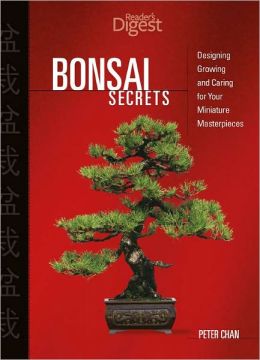 Bonsai Secrets by Peter Chan is probably the most newbie friendly book I've read on bonsai. Covering a pretty good range of topics without getting too in depth and being overwhelming, it's very useful as a introductory guide to styles, soils, pots, and pruning. Reading this book will let you get an excellent grasp of what you need to do if you're just starting out, and once you get into it, you can also read it over again and see just how far you've come. Best part of all though? It's incredibly cheap on Amazon at only 4 bucks or so for a used copy. So just to reiterate, if you're new or fairly new into bonsai or maybe you're into looking for a information resource and don't have a lot of extra dough on hand, this is the book for you. 
|
|
|







